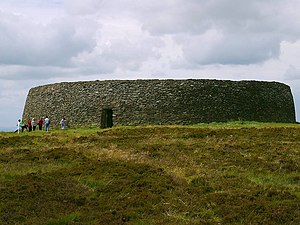Northern Uí Néill
The Northern Uí Néill was any of several dynasties in north-western medieval Ireland that claimed descent from a common ancestor, Niall of the Nine Hostages.[1][2] The Northern Uí Néill's over-kingdom in its earliest days was known as In Fochla and In Tuaiscert, both meaning 'the North', and was initially ruled by the Cenél Conaill.[4] The lack of contemporary evidence has cast doubt on the validity of traditional accounts, with questions raised about whether such an invasion actually took place, as well as whether the invaders even belonged to the Uí Néill at all.[5] This possibly involved the ruthless re-writing and doctoring of genealogies, lists of kings, history, and early annals, tracing the current situation as having primacy all the way back into the undocumented 5th century.[5] By the 13th century, the Cenél Conaill had come to dominance over the original territory of the Northern Uí Néill in County Donegal, and sponsored their own history, which incorporated elements from earlier historical revisions.[5] Known as the Eachtra Conaill Gulbain, 'The otherworld adventures of Conall Gulban',[6] it details how sons of Niall Noígiallach, the eponymous ancestor of the Uí Néill dynasties, came forth from Connacht, and invaded the north-western territory of the Ulaid,[5][7] conquering it from the indigenous people, the Dál Fiatach.[5] Niall Noígiallach has been ruled out by historian Brian Lacey as being this ancestor, providing other possible candidates including: Cana mac Luigdech Lámfhata, Dál Fiatach leader of Sentuatha Ulaid; Echu Doimlén, father of the Three Collas; or perhaps an anonymous Cruithin prince.[13] By the 11th century, having taken control of Tulach Óc, the Cenél nEógain had moved their royal seat there from Ailech, likely due to the significance of the site and that it undermined the kingship of their rivals.[15] This cumulated in 866, when the king of Ailech, Áed Finnliath, managed to clear the Vikings from their strongholds in "the North, both in Cenel Eogain and Dál nAraidi", and won a battle in Lough Foyle on the east coast of Inishowen.[3][13] Below is a chart listing the ancestry of the Cenél Conaill from Niall of the Nine Hostages, which contains figures from oral history until the 8th century when the historical period in Ireland started.

Eógan mac NéillLordship of IrelandUnited KingdomRepublic of IrelandIrelandNiall of the Nine HostagesSouthern Uí NéillUí NéillConallEógainNiall NoígiallachColla UaisUlsterTír ChonaillInis EoghainGrianan of AileachCounty DonegalÁed Allánking of TaraCongusbishop of ArmaghArmaghConnachtDál FiatachCruithinUí Echach CobaConaille Muirtheimnethe Three CollastuathaTyrconnellInishowen peninsulaking of AilechClann CholmáinAnnals of UlsterÁed OirdnideAirgiallaCianachtRiver FoyleLondonderryTyroneNorthern IrelandNiall CailleTulach ÓcMcCaulMcCannCounty ArmaghO'KaneO'NeillLough NeaghUí TuirtreFir LuírgCounty SligoO'DohertyO'DonnellO'GormleyMaguireTigernán Ua Ruairckingdom of BréifneVikingÁed FinnliathDál nAraidiLough FoyleGrianán of AilechMunsterNiall NoígíallachConall GulbanBaithéne mac BrénaindColumb CilleLasrén mac FeradaigSégéne mac FiachnaíFáilbe mac PípáinCumméne FindAdomnánCenél LugdachClann Ua DochartaigClann Ua BaighillClann Ua DomnaillDomnallClann Ua GallchobairBranches of the Cenél ConaillO'DonnellsO'DohertysO'BoylesO'GallaghersSaint ColumbaFergal mac Máele DúinNiall FrossachMáel DúinMurchadÁed FindliathNiall GlúndubMuirchertach mac NéillFlaithbertachDomnall ua NéillFergalFlaithbertach Ua NéillAed in Macaem ToinlescUa NeillAed MeithBranches of the Cenél nEógainO'NeillsMacLaughlinsKings of AilechIrish kingsIrish royal familiesAirgíallaO'Neill dynastyConnachtaCenél nEógainBranchesGaelic nobility of IrelandClandeboyeKings of UlsterEarl of TyroneViscount O'NeillO'Neill baronetsAn sluagh sidhe so i nEamhuin?High King of IrelandTyrone's RebellionTreaty of MellifontFlight of the EarlsIrish Rebellion of 1641Irish Confederate WarsO'Neill's RegimentMuiredach mac EógainMuirchertach mac MuiredaigDomnall Ilchelgach